Effective Team Work and Communication Assessment 1
VerifiedAdded on 2023/06/18
|9
|2618
|322
AI Summary
This report analyses the models and skills of communication, examples of poor communication at a work place and ways to improve communication. It includes a case scenario of Maria and Pedro, and discusses the Linear Model of Communication and Transactional Model of Communication. The report concludes with a recommendation to apply Aristotle's Model at work place.
Contribute Materials
Your contribution can guide someone’s learning journey. Share your
documents today.
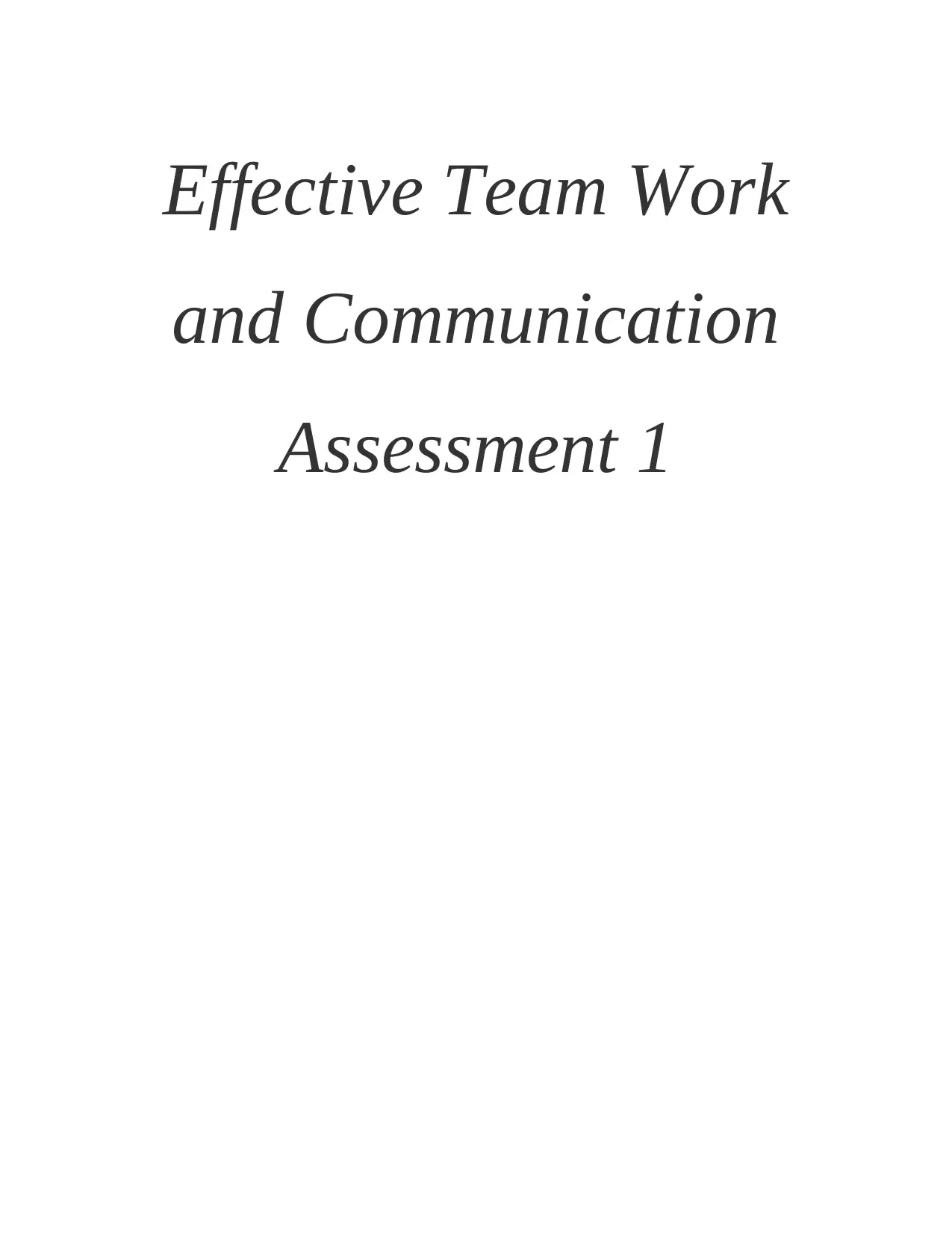
Effective Team Work
and Communication
Assessment 1
and Communication
Assessment 1
Secure Best Marks with AI Grader
Need help grading? Try our AI Grader for instant feedback on your assignments.
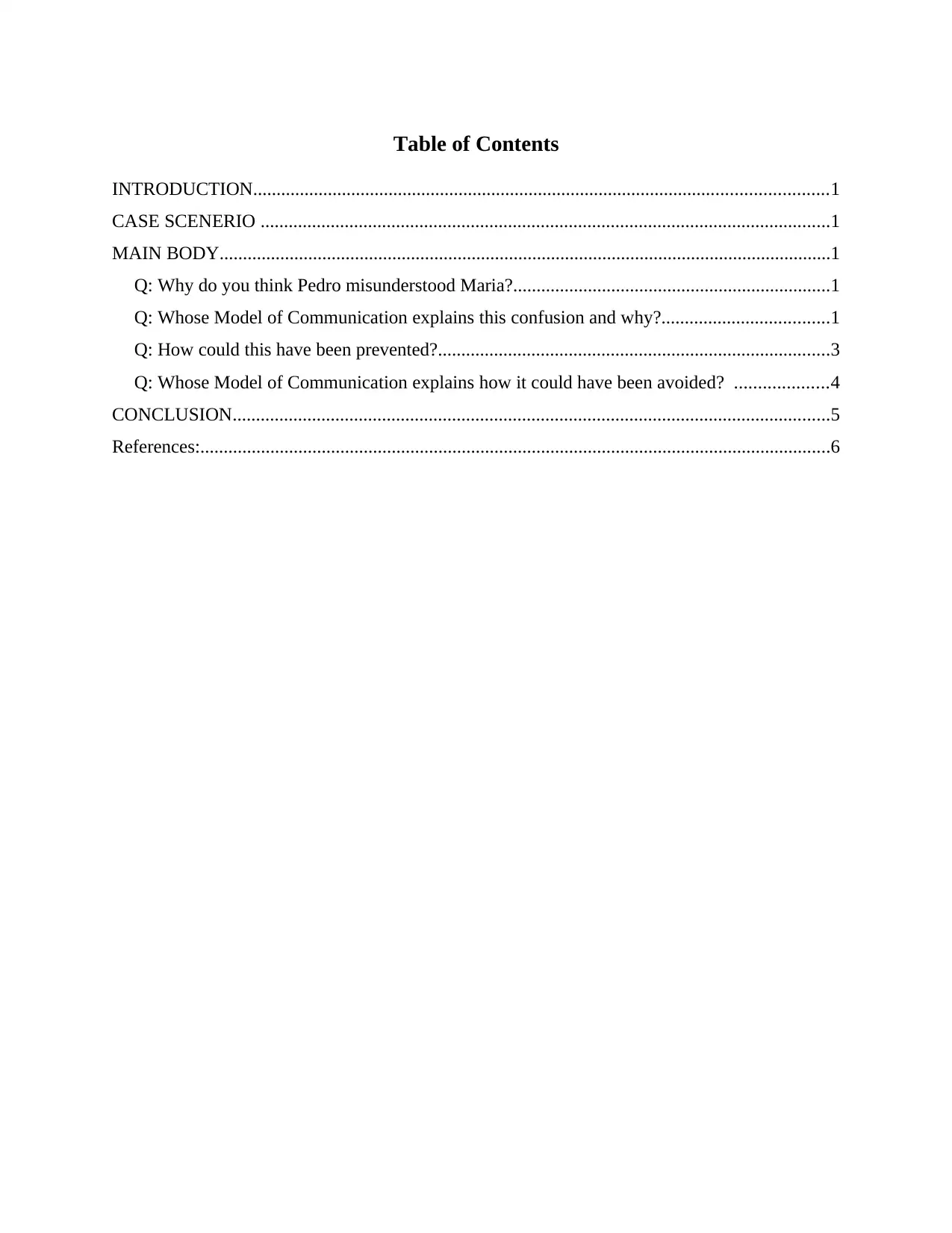
Table of Contents
INTRODUCTION...........................................................................................................................1
CASE SCENERIO ..........................................................................................................................1
MAIN BODY...................................................................................................................................1
Q: Why do you think Pedro misunderstood Maria?....................................................................1
Q: Whose Model of Communication explains this confusion and why?....................................1
Q: How could this have been prevented?....................................................................................3
Q: Whose Model of Communication explains how it could have been avoided? ....................4
CONCLUSION................................................................................................................................5
References:.......................................................................................................................................6
INTRODUCTION...........................................................................................................................1
CASE SCENERIO ..........................................................................................................................1
MAIN BODY...................................................................................................................................1
Q: Why do you think Pedro misunderstood Maria?....................................................................1
Q: Whose Model of Communication explains this confusion and why?....................................1
Q: How could this have been prevented?....................................................................................3
Q: Whose Model of Communication explains how it could have been avoided? ....................4
CONCLUSION................................................................................................................................5
References:.......................................................................................................................................6
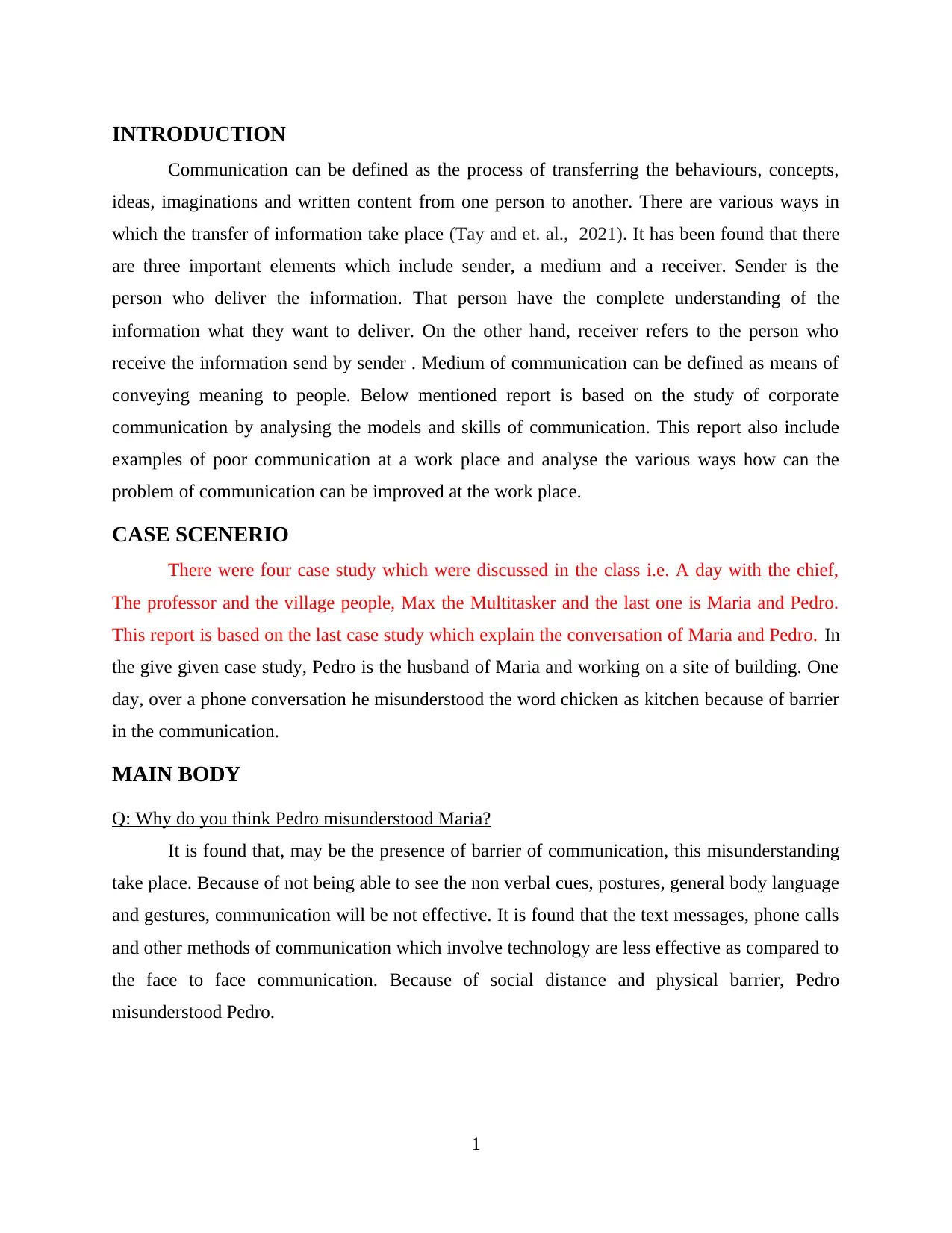
INTRODUCTION
Communication can be defined as the process of transferring the behaviours, concepts,
ideas, imaginations and written content from one person to another. There are various ways in
which the transfer of information take place (Tay and et. al., 2021). It has been found that there
are three important elements which include sender, a medium and a receiver. Sender is the
person who deliver the information. That person have the complete understanding of the
information what they want to deliver. On the other hand, receiver refers to the person who
receive the information send by sender . Medium of communication can be defined as means of
conveying meaning to people. Below mentioned report is based on the study of corporate
communication by analysing the models and skills of communication. This report also include
examples of poor communication at a work place and analyse the various ways how can the
problem of communication can be improved at the work place.
CASE SCENERIO
There were four case study which were discussed in the class i.e. A day with the chief,
The professor and the village people, Max the Multitasker and the last one is Maria and Pedro.
This report is based on the last case study which explain the conversation of Maria and Pedro. In
the give given case study, Pedro is the husband of Maria and working on a site of building. One
day, over a phone conversation he misunderstood the word chicken as kitchen because of barrier
in the communication.
MAIN BODY
Q: Why do you think Pedro misunderstood Maria?
It is found that, may be the presence of barrier of communication, this misunderstanding
take place. Because of not being able to see the non verbal cues, postures, general body language
and gestures, communication will be not effective. It is found that the text messages, phone calls
and other methods of communication which involve technology are less effective as compared to
the face to face communication. Because of social distance and physical barrier, Pedro
misunderstood Pedro.
1
Communication can be defined as the process of transferring the behaviours, concepts,
ideas, imaginations and written content from one person to another. There are various ways in
which the transfer of information take place (Tay and et. al., 2021). It has been found that there
are three important elements which include sender, a medium and a receiver. Sender is the
person who deliver the information. That person have the complete understanding of the
information what they want to deliver. On the other hand, receiver refers to the person who
receive the information send by sender . Medium of communication can be defined as means of
conveying meaning to people. Below mentioned report is based on the study of corporate
communication by analysing the models and skills of communication. This report also include
examples of poor communication at a work place and analyse the various ways how can the
problem of communication can be improved at the work place.
CASE SCENERIO
There were four case study which were discussed in the class i.e. A day with the chief,
The professor and the village people, Max the Multitasker and the last one is Maria and Pedro.
This report is based on the last case study which explain the conversation of Maria and Pedro. In
the give given case study, Pedro is the husband of Maria and working on a site of building. One
day, over a phone conversation he misunderstood the word chicken as kitchen because of barrier
in the communication.
MAIN BODY
Q: Why do you think Pedro misunderstood Maria?
It is found that, may be the presence of barrier of communication, this misunderstanding
take place. Because of not being able to see the non verbal cues, postures, general body language
and gestures, communication will be not effective. It is found that the text messages, phone calls
and other methods of communication which involve technology are less effective as compared to
the face to face communication. Because of social distance and physical barrier, Pedro
misunderstood Pedro.
1
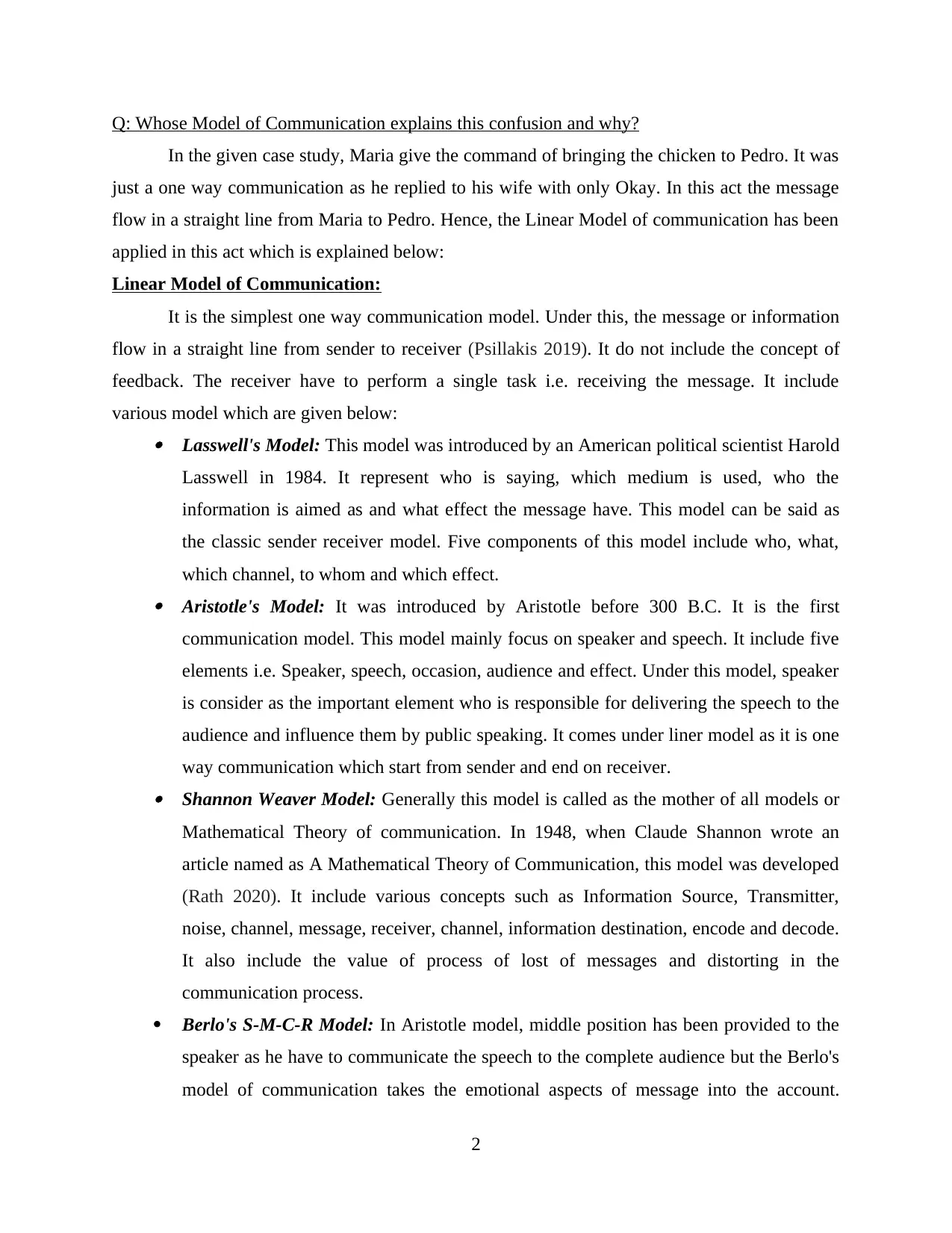
Q: Whose Model of Communication explains this confusion and why?
In the given case study, Maria give the command of bringing the chicken to Pedro. It was
just a one way communication as he replied to his wife with only Okay. In this act the message
flow in a straight line from Maria to Pedro. Hence, the Linear Model of communication has been
applied in this act which is explained below:
Linear Model of Communication:
It is the simplest one way communication model. Under this, the message or information
flow in a straight line from sender to receiver (Psillakis 2019). It do not include the concept of
feedback. The receiver have to perform a single task i.e. receiving the message. It include
various model which are given below: Lasswell's Model: This model was introduced by an American political scientist Harold
Lasswell in 1984. It represent who is saying, which medium is used, who the
information is aimed as and what effect the message have. This model can be said as
the classic sender receiver model. Five components of this model include who, what,
which channel, to whom and which effect. Aristotle's Model: It was introduced by Aristotle before 300 B.C. It is the first
communication model. This model mainly focus on speaker and speech. It include five
elements i.e. Speaker, speech, occasion, audience and effect. Under this model, speaker
is consider as the important element who is responsible for delivering the speech to the
audience and influence them by public speaking. It comes under liner model as it is one
way communication which start from sender and end on receiver. Shannon Weaver Model: Generally this model is called as the mother of all models or
Mathematical Theory of communication. In 1948, when Claude Shannon wrote an
article named as A Mathematical Theory of Communication, this model was developed
(Rath 2020). It include various concepts such as Information Source, Transmitter,
noise, channel, message, receiver, channel, information destination, encode and decode.
It also include the value of process of lost of messages and distorting in the
communication process.
Berlo's S-M-C-R Model: In Aristotle model, middle position has been provided to the
speaker as he have to communicate the speech to the complete audience but the Berlo's
model of communication takes the emotional aspects of message into the account.
2
In the given case study, Maria give the command of bringing the chicken to Pedro. It was
just a one way communication as he replied to his wife with only Okay. In this act the message
flow in a straight line from Maria to Pedro. Hence, the Linear Model of communication has been
applied in this act which is explained below:
Linear Model of Communication:
It is the simplest one way communication model. Under this, the message or information
flow in a straight line from sender to receiver (Psillakis 2019). It do not include the concept of
feedback. The receiver have to perform a single task i.e. receiving the message. It include
various model which are given below: Lasswell's Model: This model was introduced by an American political scientist Harold
Lasswell in 1984. It represent who is saying, which medium is used, who the
information is aimed as and what effect the message have. This model can be said as
the classic sender receiver model. Five components of this model include who, what,
which channel, to whom and which effect. Aristotle's Model: It was introduced by Aristotle before 300 B.C. It is the first
communication model. This model mainly focus on speaker and speech. It include five
elements i.e. Speaker, speech, occasion, audience and effect. Under this model, speaker
is consider as the important element who is responsible for delivering the speech to the
audience and influence them by public speaking. It comes under liner model as it is one
way communication which start from sender and end on receiver. Shannon Weaver Model: Generally this model is called as the mother of all models or
Mathematical Theory of communication. In 1948, when Claude Shannon wrote an
article named as A Mathematical Theory of Communication, this model was developed
(Rath 2020). It include various concepts such as Information Source, Transmitter,
noise, channel, message, receiver, channel, information destination, encode and decode.
It also include the value of process of lost of messages and distorting in the
communication process.
Berlo's S-M-C-R Model: In Aristotle model, middle position has been provided to the
speaker as he have to communicate the speech to the complete audience but the Berlo's
model of communication takes the emotional aspects of message into the account.
2
Paraphrase This Document
Need a fresh take? Get an instant paraphrase of this document with our AI Paraphraser
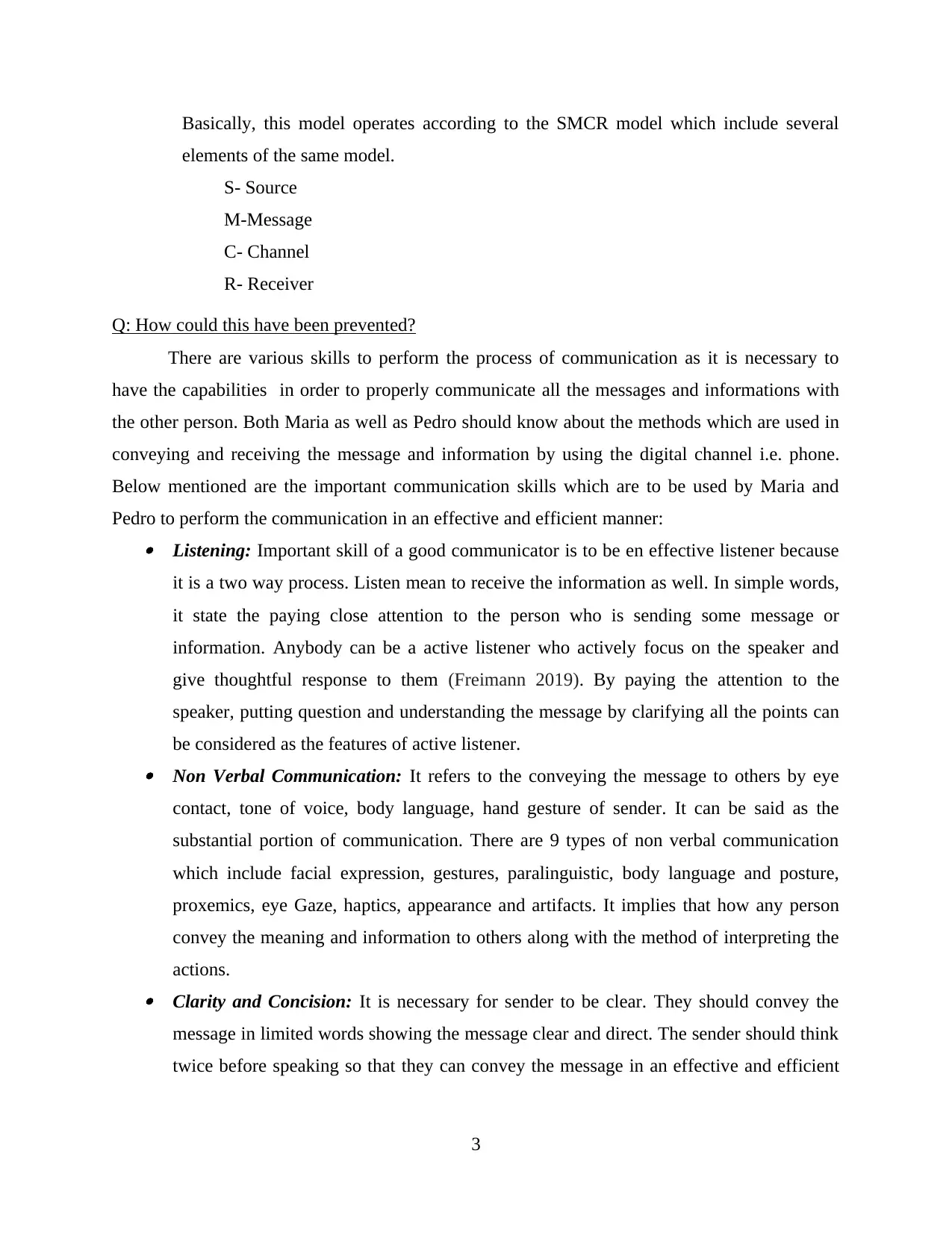
Basically, this model operates according to the SMCR model which include several
elements of the same model.
S- Source
M-Message
C- Channel
R- Receiver
Q: How could this have been prevented?
There are various skills to perform the process of communication as it is necessary to
have the capabilities in order to properly communicate all the messages and informations with
the other person. Both Maria as well as Pedro should know about the methods which are used in
conveying and receiving the message and information by using the digital channel i.e. phone.
Below mentioned are the important communication skills which are to be used by Maria and
Pedro to perform the communication in an effective and efficient manner: Listening: Important skill of a good communicator is to be en effective listener because
it is a two way process. Listen mean to receive the information as well. In simple words,
it state the paying close attention to the person who is sending some message or
information. Anybody can be a active listener who actively focus on the speaker and
give thoughtful response to them (Freimann 2019). By paying the attention to the
speaker, putting question and understanding the message by clarifying all the points can
be considered as the features of active listener. Non Verbal Communication: It refers to the conveying the message to others by eye
contact, tone of voice, body language, hand gesture of sender. It can be said as the
substantial portion of communication. There are 9 types of non verbal communication
which include facial expression, gestures, paralinguistic, body language and posture,
proxemics, eye Gaze, haptics, appearance and artifacts. It implies that how any person
convey the meaning and information to others along with the method of interpreting the
actions. Clarity and Concision: It is necessary for sender to be clear. They should convey the
message in limited words showing the message clear and direct. The sender should think
twice before speaking so that they can convey the message in an effective and efficient
3
elements of the same model.
S- Source
M-Message
C- Channel
R- Receiver
Q: How could this have been prevented?
There are various skills to perform the process of communication as it is necessary to
have the capabilities in order to properly communicate all the messages and informations with
the other person. Both Maria as well as Pedro should know about the methods which are used in
conveying and receiving the message and information by using the digital channel i.e. phone.
Below mentioned are the important communication skills which are to be used by Maria and
Pedro to perform the communication in an effective and efficient manner: Listening: Important skill of a good communicator is to be en effective listener because
it is a two way process. Listen mean to receive the information as well. In simple words,
it state the paying close attention to the person who is sending some message or
information. Anybody can be a active listener who actively focus on the speaker and
give thoughtful response to them (Freimann 2019). By paying the attention to the
speaker, putting question and understanding the message by clarifying all the points can
be considered as the features of active listener. Non Verbal Communication: It refers to the conveying the message to others by eye
contact, tone of voice, body language, hand gesture of sender. It can be said as the
substantial portion of communication. There are 9 types of non verbal communication
which include facial expression, gestures, paralinguistic, body language and posture,
proxemics, eye Gaze, haptics, appearance and artifacts. It implies that how any person
convey the meaning and information to others along with the method of interpreting the
actions. Clarity and Concision: It is necessary for sender to be clear. They should convey the
message in limited words showing the message clear and direct. The sender should think
twice before speaking so that they can convey the message in an effective and efficient
3
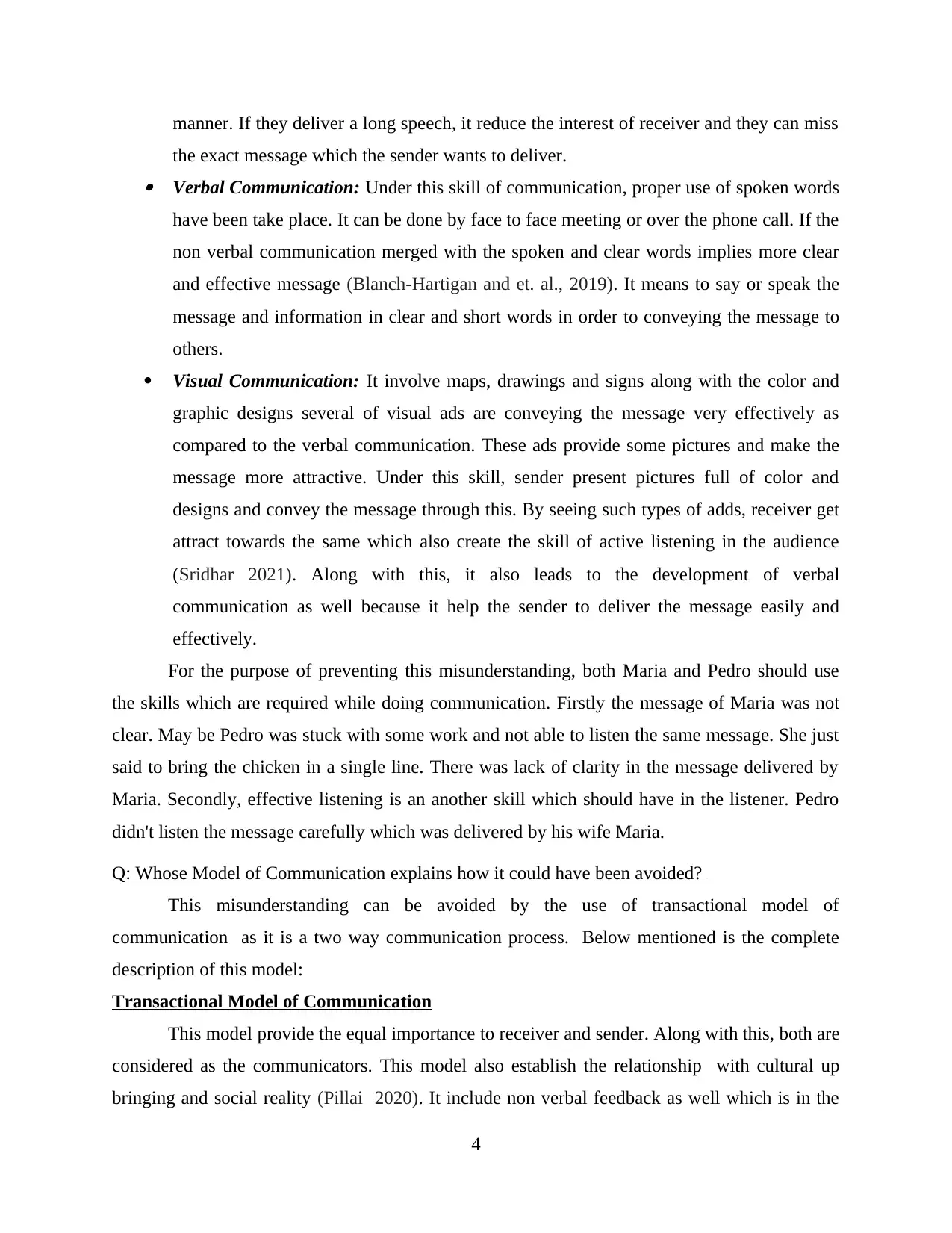
manner. If they deliver a long speech, it reduce the interest of receiver and they can miss
the exact message which the sender wants to deliver. Verbal Communication: Under this skill of communication, proper use of spoken words
have been take place. It can be done by face to face meeting or over the phone call. If the
non verbal communication merged with the spoken and clear words implies more clear
and effective message (Blanch-Hartigan and et. al., 2019). It means to say or speak the
message and information in clear and short words in order to conveying the message to
others.
Visual Communication: It involve maps, drawings and signs along with the color and
graphic designs several of visual ads are conveying the message very effectively as
compared to the verbal communication. These ads provide some pictures and make the
message more attractive. Under this skill, sender present pictures full of color and
designs and convey the message through this. By seeing such types of adds, receiver get
attract towards the same which also create the skill of active listening in the audience
(Sridhar 2021). Along with this, it also leads to the development of verbal
communication as well because it help the sender to deliver the message easily and
effectively.
For the purpose of preventing this misunderstanding, both Maria and Pedro should use
the skills which are required while doing communication. Firstly the message of Maria was not
clear. May be Pedro was stuck with some work and not able to listen the same message. She just
said to bring the chicken in a single line. There was lack of clarity in the message delivered by
Maria. Secondly, effective listening is an another skill which should have in the listener. Pedro
didn't listen the message carefully which was delivered by his wife Maria.
Q: Whose Model of Communication explains how it could have been avoided?
This misunderstanding can be avoided by the use of transactional model of
communication as it is a two way communication process. Below mentioned is the complete
description of this model:
Transactional Model of Communication
This model provide the equal importance to receiver and sender. Along with this, both are
considered as the communicators. This model also establish the relationship with cultural up
bringing and social reality (Pillai 2020). It include non verbal feedback as well which is in the
4
the exact message which the sender wants to deliver. Verbal Communication: Under this skill of communication, proper use of spoken words
have been take place. It can be done by face to face meeting or over the phone call. If the
non verbal communication merged with the spoken and clear words implies more clear
and effective message (Blanch-Hartigan and et. al., 2019). It means to say or speak the
message and information in clear and short words in order to conveying the message to
others.
Visual Communication: It involve maps, drawings and signs along with the color and
graphic designs several of visual ads are conveying the message very effectively as
compared to the verbal communication. These ads provide some pictures and make the
message more attractive. Under this skill, sender present pictures full of color and
designs and convey the message through this. By seeing such types of adds, receiver get
attract towards the same which also create the skill of active listening in the audience
(Sridhar 2021). Along with this, it also leads to the development of verbal
communication as well because it help the sender to deliver the message easily and
effectively.
For the purpose of preventing this misunderstanding, both Maria and Pedro should use
the skills which are required while doing communication. Firstly the message of Maria was not
clear. May be Pedro was stuck with some work and not able to listen the same message. She just
said to bring the chicken in a single line. There was lack of clarity in the message delivered by
Maria. Secondly, effective listening is an another skill which should have in the listener. Pedro
didn't listen the message carefully which was delivered by his wife Maria.
Q: Whose Model of Communication explains how it could have been avoided?
This misunderstanding can be avoided by the use of transactional model of
communication as it is a two way communication process. Below mentioned is the complete
description of this model:
Transactional Model of Communication
This model provide the equal importance to receiver and sender. Along with this, both are
considered as the communicators. This model also establish the relationship with cultural up
bringing and social reality (Pillai 2020). It include non verbal feedback as well which is in the
4

form of gestures and body language. Below mentioned are models which comes under
Transactional Model of Communication: Barnlund's Transactional Model: In 1970, Dean Barnlund present a transactional model
of communication for the purpose of helping in the elucidation of relational
communication which highlight that the sending and receiving of information occur only
once among two persons. In addition to this, it also include the feedback system along
with multiple layers implying that anybody can be sender or receiver on the same time.
This model include 3 components i.e. Public cues, Private cues and behavioural cues. Helical Model: This model is also known as Dance Helix Model as it was introduced by
Frank Dance in 1967. under this model, communication has been explained by using a
helix. It is a smooth curve which is similar to spring which definitely comes downwards
if it go upward. This model highlight the problems of communication. He used Helix
which takes a big shape when it moves or grows (Shehata 2019). In the structure of
Helix, it is found that the starting point is very small but when it flow in circular form, it
become bigger circle from top. For instance, when a child born, he/she can communicate
only by crying. As the child grow, the means of communication become wider and
broader.
Becker's Mosaic Model: This model was developed by Sam Becker. He disagree with
the traditional concepts of communication as they include vary limited usefulness in
order to understanding the modern communication. In simple words it can be said that
this model deals with the complications in human communication. It also include various
number of particles or bits of information on huge number of topics.
CONCLUSION
It has been concluded from the above report that communication is an important factor at
work place as it helps in maintaining a relationship among various people. By using some
channel and language, one person can communicate ideas and information to other. Various of
specialist has introduced several number of models which are useful according to the work
culture and requirement of organisation. Along with this, it is also analysed that the
communication can happen only in three ways i.e. verbal, non verbal and visual. Above
mentioned report is clearly highlighting the various models and various skills of communication.
It is necessary for the employees of organisation to have strong communication skills so that they
5
Transactional Model of Communication: Barnlund's Transactional Model: In 1970, Dean Barnlund present a transactional model
of communication for the purpose of helping in the elucidation of relational
communication which highlight that the sending and receiving of information occur only
once among two persons. In addition to this, it also include the feedback system along
with multiple layers implying that anybody can be sender or receiver on the same time.
This model include 3 components i.e. Public cues, Private cues and behavioural cues. Helical Model: This model is also known as Dance Helix Model as it was introduced by
Frank Dance in 1967. under this model, communication has been explained by using a
helix. It is a smooth curve which is similar to spring which definitely comes downwards
if it go upward. This model highlight the problems of communication. He used Helix
which takes a big shape when it moves or grows (Shehata 2019). In the structure of
Helix, it is found that the starting point is very small but when it flow in circular form, it
become bigger circle from top. For instance, when a child born, he/she can communicate
only by crying. As the child grow, the means of communication become wider and
broader.
Becker's Mosaic Model: This model was developed by Sam Becker. He disagree with
the traditional concepts of communication as they include vary limited usefulness in
order to understanding the modern communication. In simple words it can be said that
this model deals with the complications in human communication. It also include various
number of particles or bits of information on huge number of topics.
CONCLUSION
It has been concluded from the above report that communication is an important factor at
work place as it helps in maintaining a relationship among various people. By using some
channel and language, one person can communicate ideas and information to other. Various of
specialist has introduced several number of models which are useful according to the work
culture and requirement of organisation. Along with this, it is also analysed that the
communication can happen only in three ways i.e. verbal, non verbal and visual. Above
mentioned report is clearly highlighting the various models and various skills of communication.
It is necessary for the employees of organisation to have strong communication skills so that they
5
Secure Best Marks with AI Grader
Need help grading? Try our AI Grader for instant feedback on your assignments.

can maintain a good relationship among the employees at work place. Marks and Spencer is
facing the problem of arguments among the employees. It has been suggested to apply Aristotle's
Model at work place in the recommendation portion.
6
facing the problem of arguments among the employees. It has been suggested to apply Aristotle's
Model at work place in the recommendation portion.
6
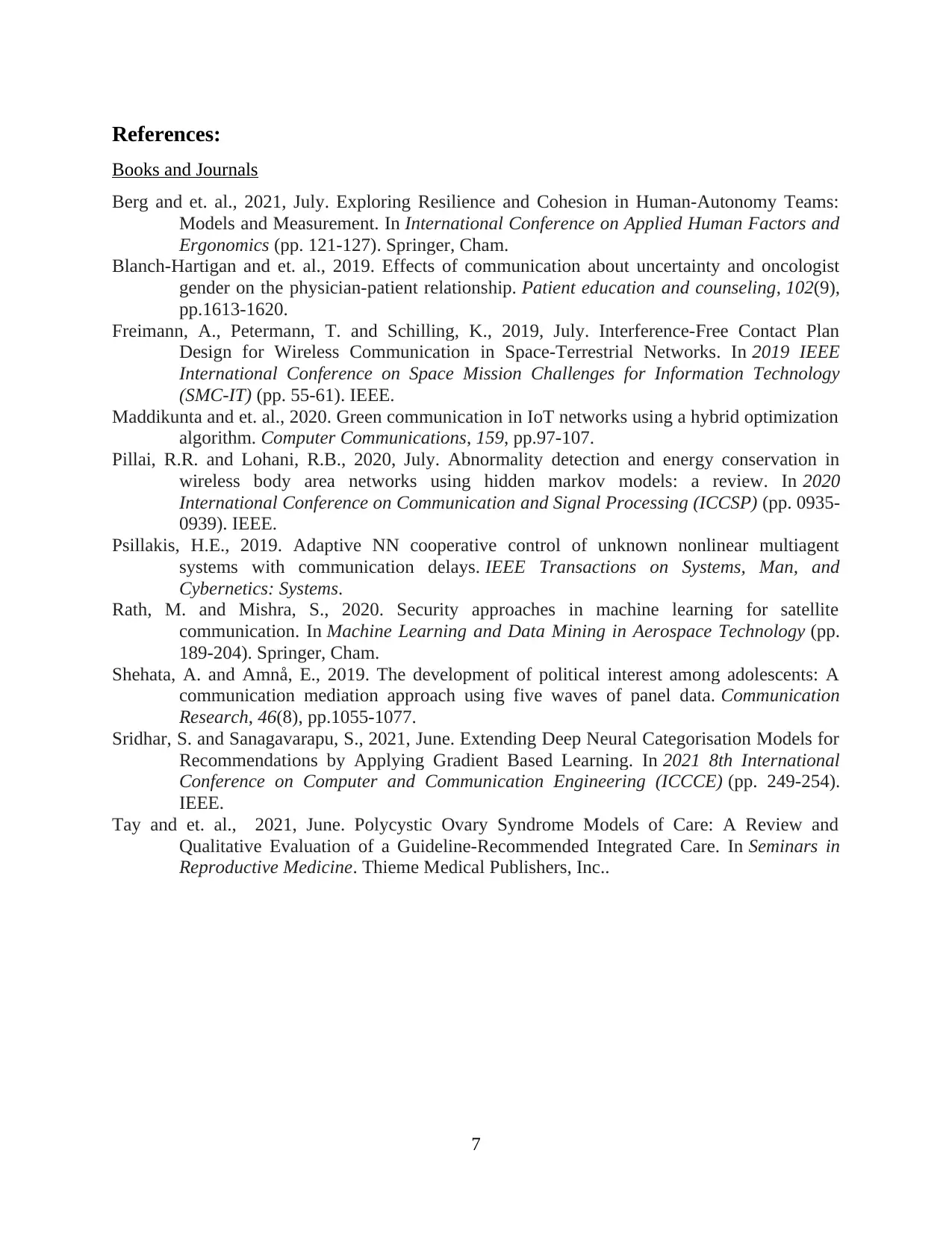
References:
Books and Journals
Berg and et. al., 2021, July. Exploring Resilience and Cohesion in Human-Autonomy Teams:
Models and Measurement. In International Conference on Applied Human Factors and
Ergonomics (pp. 121-127). Springer, Cham.
Blanch-Hartigan and et. al., 2019. Effects of communication about uncertainty and oncologist
gender on the physician-patient relationship. Patient education and counseling, 102(9),
pp.1613-1620.
Freimann, A., Petermann, T. and Schilling, K., 2019, July. Interference-Free Contact Plan
Design for Wireless Communication in Space-Terrestrial Networks. In 2019 IEEE
International Conference on Space Mission Challenges for Information Technology
(SMC-IT) (pp. 55-61). IEEE.
Maddikunta and et. al., 2020. Green communication in IoT networks using a hybrid optimization
algorithm. Computer Communications, 159, pp.97-107.
Pillai, R.R. and Lohani, R.B., 2020, July. Abnormality detection and energy conservation in
wireless body area networks using hidden markov models: a review. In 2020
International Conference on Communication and Signal Processing (ICCSP) (pp. 0935-
0939). IEEE.
Psillakis, H.E., 2019. Adaptive NN cooperative control of unknown nonlinear multiagent
systems with communication delays. IEEE Transactions on Systems, Man, and
Cybernetics: Systems.
Rath, M. and Mishra, S., 2020. Security approaches in machine learning for satellite
communication. In Machine Learning and Data Mining in Aerospace Technology (pp.
189-204). Springer, Cham.
Shehata, A. and Amnå, E., 2019. The development of political interest among adolescents: A
communication mediation approach using five waves of panel data. Communication
Research, 46(8), pp.1055-1077.
Sridhar, S. and Sanagavarapu, S., 2021, June. Extending Deep Neural Categorisation Models for
Recommendations by Applying Gradient Based Learning. In 2021 8th International
Conference on Computer and Communication Engineering (ICCCE) (pp. 249-254).
IEEE.
Tay and et. al., 2021, June. Polycystic Ovary Syndrome Models of Care: A Review and
Qualitative Evaluation of a Guideline-Recommended Integrated Care. In Seminars in
Reproductive Medicine. Thieme Medical Publishers, Inc..
7
Books and Journals
Berg and et. al., 2021, July. Exploring Resilience and Cohesion in Human-Autonomy Teams:
Models and Measurement. In International Conference on Applied Human Factors and
Ergonomics (pp. 121-127). Springer, Cham.
Blanch-Hartigan and et. al., 2019. Effects of communication about uncertainty and oncologist
gender on the physician-patient relationship. Patient education and counseling, 102(9),
pp.1613-1620.
Freimann, A., Petermann, T. and Schilling, K., 2019, July. Interference-Free Contact Plan
Design for Wireless Communication in Space-Terrestrial Networks. In 2019 IEEE
International Conference on Space Mission Challenges for Information Technology
(SMC-IT) (pp. 55-61). IEEE.
Maddikunta and et. al., 2020. Green communication in IoT networks using a hybrid optimization
algorithm. Computer Communications, 159, pp.97-107.
Pillai, R.R. and Lohani, R.B., 2020, July. Abnormality detection and energy conservation in
wireless body area networks using hidden markov models: a review. In 2020
International Conference on Communication and Signal Processing (ICCSP) (pp. 0935-
0939). IEEE.
Psillakis, H.E., 2019. Adaptive NN cooperative control of unknown nonlinear multiagent
systems with communication delays. IEEE Transactions on Systems, Man, and
Cybernetics: Systems.
Rath, M. and Mishra, S., 2020. Security approaches in machine learning for satellite
communication. In Machine Learning and Data Mining in Aerospace Technology (pp.
189-204). Springer, Cham.
Shehata, A. and Amnå, E., 2019. The development of political interest among adolescents: A
communication mediation approach using five waves of panel data. Communication
Research, 46(8), pp.1055-1077.
Sridhar, S. and Sanagavarapu, S., 2021, June. Extending Deep Neural Categorisation Models for
Recommendations by Applying Gradient Based Learning. In 2021 8th International
Conference on Computer and Communication Engineering (ICCCE) (pp. 249-254).
IEEE.
Tay and et. al., 2021, June. Polycystic Ovary Syndrome Models of Care: A Review and
Qualitative Evaluation of a Guideline-Recommended Integrated Care. In Seminars in
Reproductive Medicine. Thieme Medical Publishers, Inc..
7
1 out of 9
Related Documents
Your All-in-One AI-Powered Toolkit for Academic Success.
+13062052269
info@desklib.com
Available 24*7 on WhatsApp / Email
![[object Object]](/_next/static/media/star-bottom.7253800d.svg)
Unlock your academic potential
© 2024 | Zucol Services PVT LTD | All rights reserved.




